Scholastic Bundle
How Well Do You Know the Scholastic Company?
Dive into the fascinating Scholastic SWOT Analysis and discover the remarkable story of Scholastic Corporation, a company that has shaped generations of young readers. From its humble beginnings in 1920, Scholastic has evolved from a high school newspaper publisher to a global leader in children's publishing and education. Explore the pivotal moments and innovations that have defined the brief history of Scholastic, and its enduring impact on literacy.
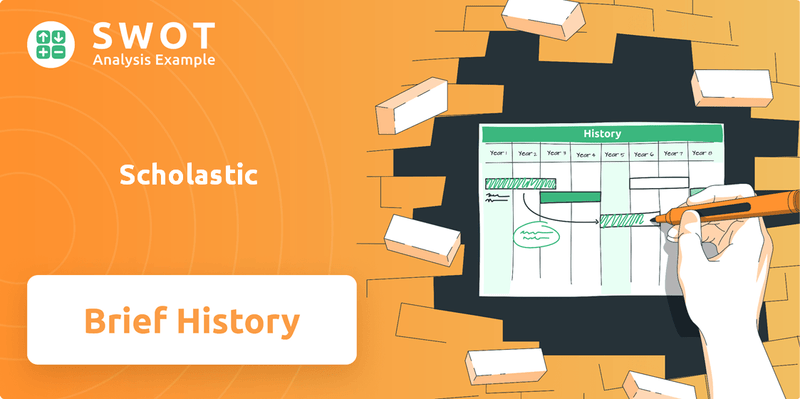
This brief history of Scholastic unveils the early days of Scholastic, tracing its journey from a small venture to a publishing giant. The Scholastic company's commitment to Scholastic books and educational resources has made it a household name. Understanding Scholastic's founding year and key milestones provides valuable insights into its enduring legacy, and its continued influence on children's literature and education.
What is the Scholastic Founding Story?
The Scholastic company, a name synonymous with children's literature and educational resources, has a rich history that began over a century ago. The brief history of Scholastic is a story of innovation and a deep understanding of the needs of young readers. From its humble beginnings, the company has grown into a global leader in publishing and education.
The Scholastic Corporation was founded on October 22, 1920, by Maurice R. Robinson. Robinson, a former teacher and journalist, saw an opportunity to provide engaging reading materials for high school students. He recognized that existing curricula often failed to connect with students' interests. His vision was to bridge this gap by delivering relevant content directly to students through their schools.
The initial business model centered around publishing 'The Western Pennsylvania Scholastic,' a high school newspaper that later evolved into 'Scholastic Magazine.' This publication aimed to inform and inspire young readers, offering a mix of news, fiction, and educational articles. Early funding came from Robinson's personal savings and possibly small investments. The name 'Scholastic' was chosen to reflect its target audience and mission: providing educational content for scholars. The early challenges included establishing distribution networks within schools and gaining acceptance from educators. Robinson's background in education and journalism uniquely positioned him to pursue this venture. The cultural context of the post-World War I era, with a growing emphasis on education, also influenced the company's creation.
Maurice R. Robinson's vision led to the creation of Scholastic, focusing on engaging content for students.
- The initial publication was 'The Western Pennsylvania Scholastic,' later known as 'Scholastic Magazine.'
- Robinson's background in education and journalism was crucial for understanding the needs of students and the publishing process.
- The company's early success was built on direct distribution to schools and a focus on relevant content.
- The post-World War I era provided a favorable environment for the growth of educational initiatives.
During the early years, the company focused on establishing its presence in schools and gaining acceptance from educators who were accustomed to traditional textbooks. Robinson's understanding of both education and publishing, helped Scholastic navigate these initial hurdles. The company's commitment to providing engaging and relevant content quickly resonated with students and educators alike. The impact of Scholastic on education began to take shape in these early days, setting the stage for its future growth and influence. To understand the company's values, read more about the Mission, Vision & Core Values of Scholastic.
Scholastic SWOT Analysis
- Complete SWOT Breakdown
- Fully Customizable
- Editable in Excel & Word
- Professional Formatting
- Investor-Ready Format
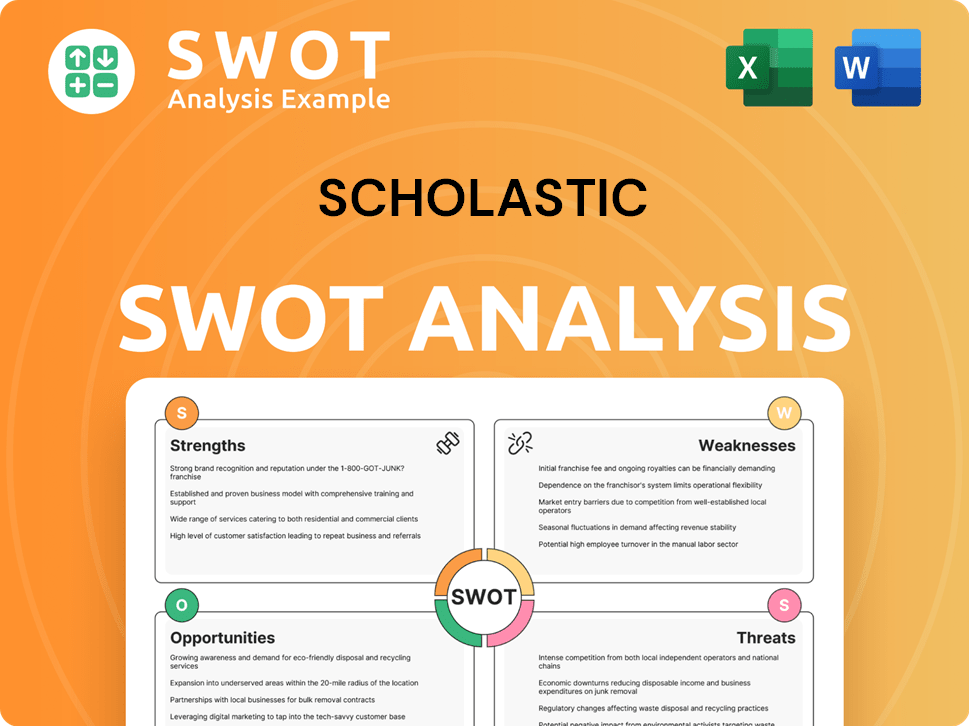
What Drove the Early Growth of Scholastic?
The early growth of the Scholastic company was significantly shaped by the success of 'Scholastic Magazine.' This publication, initially distributed in Western Pennsylvania, quickly expanded to a national audience. The brief history of Scholastic reveals a strategic diversification into educational materials, solidifying its presence in the school market during the 1930s.
The initial success of 'Scholastic Magazine' drove the company's early expansion. Its distribution grew from local to national, laying the foundation for Scholastic's broader reach. This expansion was crucial in establishing Scholastic as a key player in educational publishing.
Recognizing the needs of its audience, Scholastic expanded its offerings beyond the magazine. Workbooks and supplementary texts were introduced, marking a strategic move. This diversification was key to solidifying Scholastic's presence in the school market during the 1930s.
A pivotal moment in Scholastic's history was the 1948 launch of its book club model. This innovative approach allowed children to purchase affordable Scholastic books directly through their schools. The book club model became a cornerstone of the company's business, revolutionizing access to literature.
To support its growing operations, Scholastic expanded its team significantly. The company hired editors, sales representatives, and distribution personnel. Early office locations, primarily in New York City, served as a central hub for publishing activities.
The entry of Scholastic publishing into children's books marked a strategic shift. The company's direct-to-school model and engaging content gave it a distinct advantage. Leadership continuity under the Robinson family ensured the preservation of the founding vision. The market's positive reception addressed the demand for accessible educational resources. For more insights into Scholastic's target audience, explore Target Market of Scholastic.
Scholastic PESTLE Analysis
- Covers All 6 PESTLE Categories
- No Research Needed – Save Hours of Work
- Built by Experts, Trusted by Consultants
- Instant Download, Ready to Use
- 100% Editable, Fully Customizable
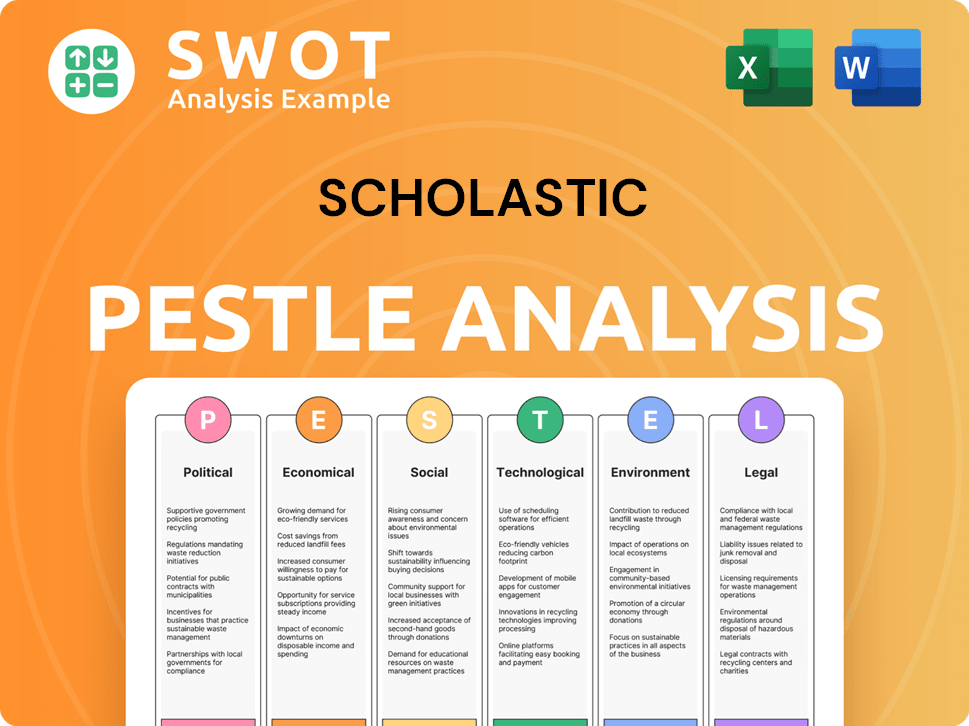
What are the key Milestones in Scholastic history?
The Scholastic history is marked by significant milestones that have shaped its trajectory in the publishing and education sectors. From its early days to its current standing as a major player, the
| Year | Milestone |
|---|---|
| 1920 | The company was founded by Maurice R. Robinson, initially publishing magazines for high school students. |
| 1948 | Scholastic Book Clubs were introduced, revolutionizing access to books for children in schools. |
| 1981 | Scholastic Book Fairs were launched, creating immersive book-buying experiences within schools. |
| 1995 | Scholastic.com was launched, marking the company's entry into the digital realm. |
| 2000 | The acquisition of Klutz expanded the company's offerings into creative products. |
The
The introduction of Scholastic Book Clubs in 1948 made books more accessible and affordable for children across the country. This initiative significantly boosted literacy rates and established a direct connection with young readers.
Launched in 1981, Scholastic Book Fairs transformed the way children purchased books, creating an engaging environment within schools. These events became a major revenue stream and a key part of the company's strategy.
The launch of Scholastic.com in 1995 and the development of educational software and digital learning platforms marked a significant shift towards digital content. This move allowed Scholastic to adapt to the evolving needs of students and educators.
The partnership with J.K. Rowling for the Harry Potter series in the U.S. market was a major success, generating billions in sales. This series had a profound impact on children's literature and significantly boosted Scholastic's revenue.
The
The 2008 financial crisis and other economic downturns impacted consumer spending on books and educational materials. These events required strategic adjustments to maintain profitability.
The rise of digital media and e-books presented a significant competitive threat, necessitating adaptation in content delivery and business models. Scholastic has responded by expanding its digital offerings.
Managing a large and diverse portfolio of products and services, along with evolving educational standards, presented ongoing operational complexities. Restructuring and strategic realignments were often necessary.
The COVID-19 pandemic highlighted the critical need for remote learning solutions, an area where Scholastic leveraged its digital platforms. This event accelerated the company's focus on digital education.
In response to these challenges, Scholastic has often undergone restructuring, rebranding efforts, and leadership changes. These actions have aimed to realign the company with market demands and technological shifts.
The company has increasingly focused on its digital education solutions segment, which saw growth in recent years. This strategic shift reflects the company's adaptation to the changing educational landscape.
Scholastic Business Model Canvas
- Complete 9-Block Business Model Canvas
- Effortlessly Communicate Your Business Strategy
- Investor-Ready BMC Format
- 100% Editable and Customizable
- Clear and Structured Layout
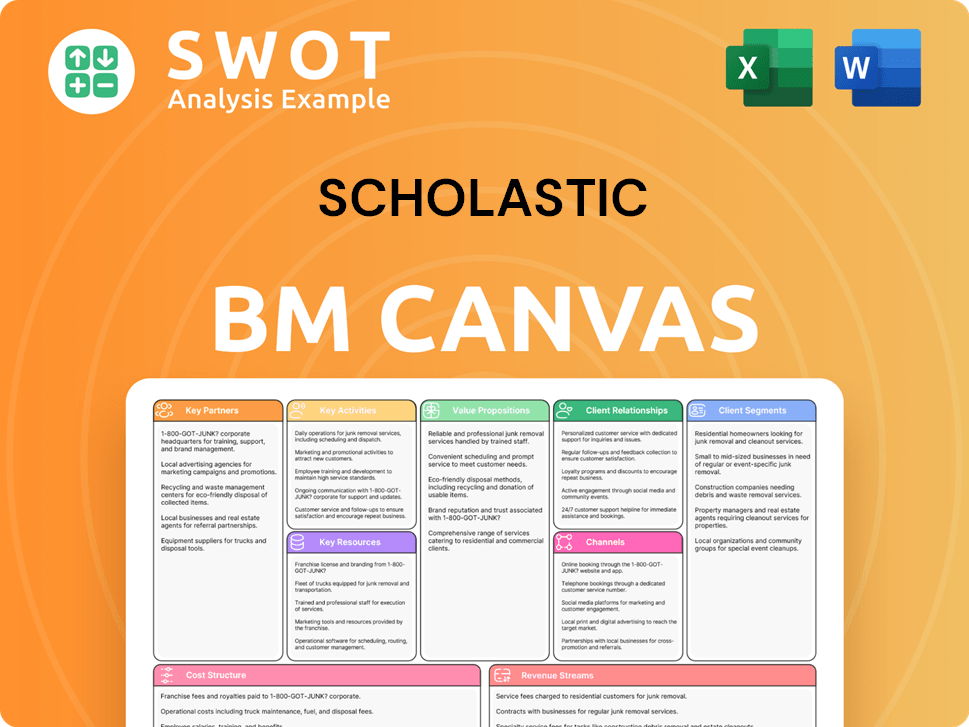
What is the Timeline of Key Events for Scholastic?
The Scholastic company has a rich history, marked by key milestones. Founded in 1920 by Maurice R. Robinson, Scholastic began as a magazine publisher. Over the years, it evolved, introducing Scholastic Book Clubs in 1948, going public in 1961, and launching Scholastic Book Fairs in 1981. The 1990s saw the rise of Scholastic.com and the publication of 'Harry Potter,' while the 2000s brought acquisitions like Klutz. More recently, the company has focused on digital education solutions and celebrated its 100th anniversary in 2020.
| Year | Key Event |
|---|---|
| 1920 | Maurice R. Robinson founded Scholastic in Wilkinsburg, PA, publishing 'The Western Pennsylvania Scholastic.' |
| 1922 | 'The Western Pennsylvania Scholastic' became 'Scholastic Magazine,' distributing nationally. |
| 1948 | Scholastic Book Clubs were established, revolutionizing book access for children. |
| 1961 | Scholastic became a publicly traded company. |
| 1981 | Scholastic Book Fairs were launched, providing on-site book sales in schools. |
| 1995 | Scholastic.com was launched, marking the company's entry into digital platforms. |
| 1997 | Scholastic published 'Harry Potter and the Sorcerer's Stone' in the U.S., becoming a cultural phenomenon. |
| 2000 | Acquired Klutz, expanding its hands-on learning and activity book offerings. |
| 2010s | Increased focus on digital education solutions and adaptive learning technologies. |
| 2020 | Celebrated 100th anniversary, adapting to remote learning needs during the pandemic. |
| 2023-2024 | Continues to invest in digital platforms and international expansion, adapting to evolving educational trends. |
Scholastic is actively expanding its digital offerings. They are investing in online learning platforms to meet the growing demand for digital education resources. This includes developing interactive content and personalized learning experiences.
The company is focused on global expansion. This includes translating books into multiple languages and adapting content for diverse cultural contexts. Scholastic aims to increase its presence in international markets.
Scholastic is committed to creating innovative content. This includes developing new series and formats to engage children. They are also focusing on diverse and inclusive stories.
The digital education market is expected to continue growing. This growth aligns with Scholastic's strategic investments in its Education Solutions segment. They are positioned to capitalize on these trends.
Scholastic Porter's Five Forces Analysis
- Covers All 5 Competitive Forces in Detail
- Structured for Consultants, Students, and Founders
- 100% Editable in Microsoft Word & Excel
- Instant Digital Download – Use Immediately
- Compatible with Mac & PC – Fully Unlocked
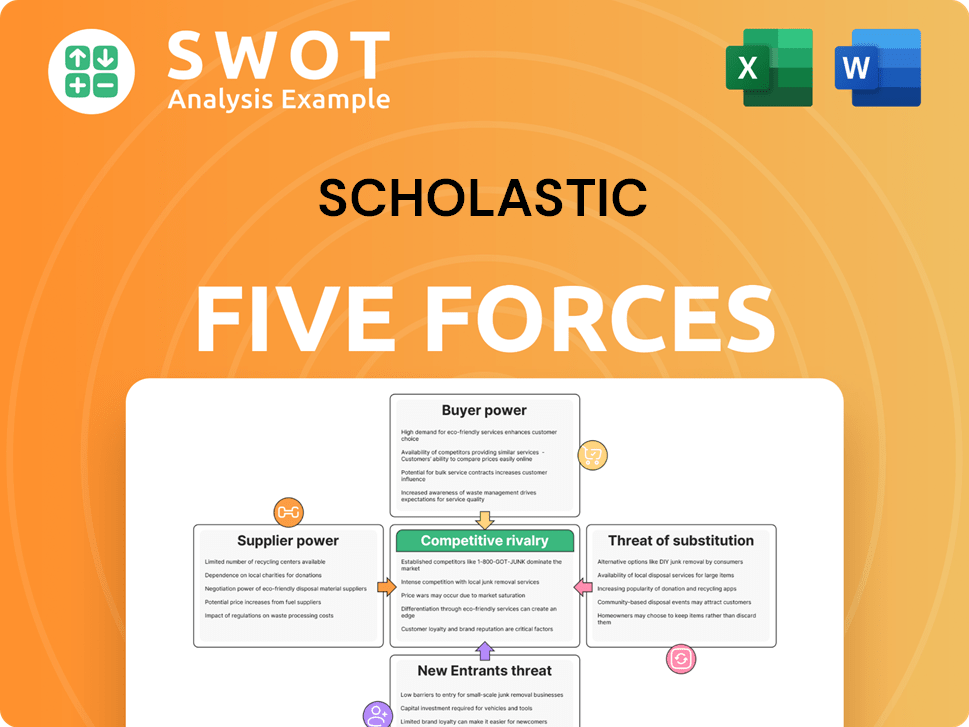
Related Blogs
- What is Competitive Landscape of Scholastic Company?
- What is Growth Strategy and Future Prospects of Scholastic Company?
- How Does Scholastic Company Work?
- What is Sales and Marketing Strategy of Scholastic Company?
- What is Brief History of Scholastic Company?
- Who Owns Scholastic Company?
- What is Customer Demographics and Target Market of Scholastic Company?
Disclaimer
All information, articles, and product details provided on this website are for general informational and educational purposes only. We do not claim any ownership over, nor do we intend to infringe upon, any trademarks, copyrights, logos, brand names, or other intellectual property mentioned or depicted on this site. Such intellectual property remains the property of its respective owners, and any references here are made solely for identification or informational purposes, without implying any affiliation, endorsement, or partnership.
We make no representations or warranties, express or implied, regarding the accuracy, completeness, or suitability of any content or products presented. Nothing on this website should be construed as legal, tax, investment, financial, medical, or other professional advice. In addition, no part of this site—including articles or product references—constitutes a solicitation, recommendation, endorsement, advertisement, or offer to buy or sell any securities, franchises, or other financial instruments, particularly in jurisdictions where such activity would be unlawful.
All content is of a general nature and may not address the specific circumstances of any individual or entity. It is not a substitute for professional advice or services. Any actions you take based on the information provided here are strictly at your own risk. You accept full responsibility for any decisions or outcomes arising from your use of this website and agree to release us from any liability in connection with your use of, or reliance upon, the content or products found herein.